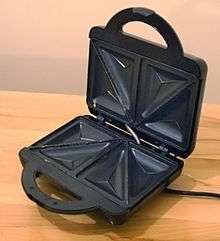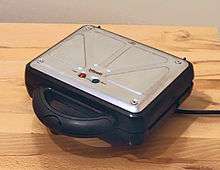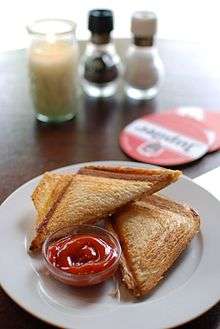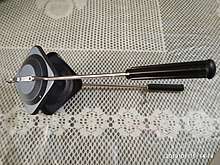Pie iron
A pie iron — also called pudgy pie iron, sandwich toaster, snackwicher, jaffle iron, or toastie iron — is a cooking appliance that consists of two hinged concave, round or square, cast iron (or aluminum) plates on long handles. Its "clamshell" design resembles that of a waffle iron, but without that appliance's honeycomb pattern. Pie irons are used to heat, toast and seal a sandwich — typically called a "toastie" or a 'Breville' — consisting of two slices of bread enclosing a filling.


Name
The most common type in most countries are electrically heated counter-top models, and names vary from place to place: in the United Kingdom, the pie iron is referred to as a "sandwich maker", in Australia, it may be called a Breville after the appliance manufacturer; in Scotland and Ireland, it may be called a "toastie maker"; and it is sometimes referred to as a "snackwich-maker" or "snackwicher" in South Africa. The term "jaffle maker" is also used in Australia and Indonesia.[1]
Origins
In the U.S., the Tostwich is possibly the earliest toasted sandwich maker, dating back to before 1920. However, it was not patented until 3 March 1925 (applied for on 26 May 1924). It was invented by Charles Champion, whose other inventions include a corn-popping machine for the mass-production of popcorn.[2]
The original Jaffle brand jaffle iron was designed and patented in 1949 by Dr Earnest Smithers of Bondi Australia.
Pie irons were popular with campers in the 1960s and '70s in the United States. Called "tonka toasters," recipes called for cutting the crusts from white bread and placing the long-handled iron in the coals of a camp fire for the time estimated to form a golden-brown crust. Canned pie filling was the most popular filling, though other combinations of meat/egg and vegetable filling recipes were circulated as ideas for camp food.
Operation

Modern versions of the pie-iron are commonly more domestic, if not necessarily more refined, with subdivisions allowing pairs of bread slices to be clamped together around fillings to form pockets or stuffed sandwiches. A combination of heat and pressure seals the bread at the outer edges.
Campfire versions are still made of cast iron and can be cooked over coals, open flames, or over a stove but lightweight aluminium stove-top versions are made, generally being coated with a non-stick surface both as a cleaning aid and to allay fears regarding aluminium in the diet.
Once the device is hot, the sandwich can be assembled 'inside out' where the buttered side of the bread faces outwards against the metal plates and the filling sits inside. This produces a crunchier 'toastie' and helps prevent the bread from sticking.[4] Alternatively, bread can be placed inside unbuttered which produces a chewier 'toastie'.[4]
An alternative counter-top preparation method—one more common in the U.S.—employs a toaster oven where the sandwich (toastie) is arranged open face and then toasted (grilled), which not only toasts the bread but warms the meat and melts the cheese that is the traditional content of the classic Dutch toasted sandwich. While most informal eateries in Europe offer some form of toasted sandwich very few use clamshell-makers, preferring the grill or toaster-oven methods already mentioned, however American restaurants with a high customer turnover sometimes invest in large conveyor belt toaster ovens, such as can be found at Quizno's, Subway and Boston Market.
Regional variants

- Rights acquired by John O'Brien for Australian cookware company Breville in the 1970s[5] mean that the name Breville is sometimes used there eponymously to describe both the device and the toasted, sealed sandwich product.[6]
- In the UK, the "sandwich maker", or "toastie maker", is notorious for being little-used. A survey in 2005 suggested that 45% of British adults own, but do not use, sandwich toasters.[7]
- In India particularly in Mumbai open flame toasters are used to toast sandwiches . They are often called Bombay Sandwiches
See also
References
- "1949 Jaffle craze hits Australia". Australian food history timeline. Retrieved 11 July 2018.
- "Catlin's Own Inventor", Shirley Nesbitt, 2000, accessed 26 December 2007
- https://australianfoodtimeline.com.au/jaffle-craze/
- "Toasted sandwich; Butter the outside or not?". Piston Heads. 2015. Retrieved 19 October 2017.
- "From the Vault: Toasted Sandwich Maker". The New Inventors. ABC Television. Retrieved 16 May 2011.
- "The Original 4-Slice". Breville Product Information. Retrieved 16 May 2011.
- The Telegraph, 12 September 2005, Sarah Womack, "£9bn wasted on unused gadgets for our homes", London, https://www.telegraph.co.uk/news/uknews/1498205/9bn-wasted-on-unused-gadgets-for-our-homes.html